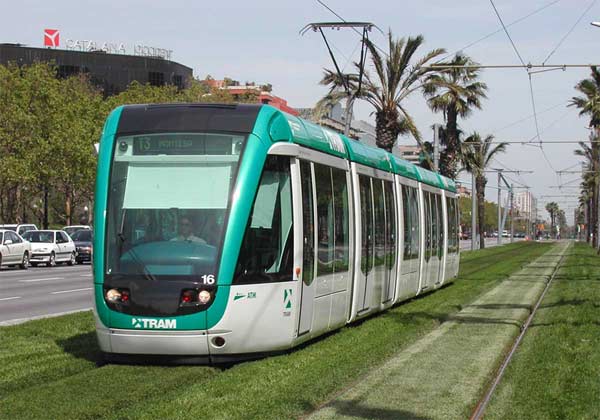Trams for the 21st Century – Alstom Citadis
Bombardier and Siemens trams also have stiff competition from France’s Alstom’s Citadis modular tram.
Alstolm’sAi??Ai??Citadis family of modular tramsAi??Ai??includes both partially low-floor and 100% low-floor trams,Ai??Ai??which can be delivered inAi??Ai??three, five, and seven sections, to suit the needs of individual costumers.
The Citadis family of modular tramsAi??Ai??comprises of:
- Citadis 100 – three section, 70% low floor, designed and manufactured in Alstom-Konstal plant in ChorzA?A?w for polish market (Katowice, GdaAi??ai??zsk)
- Citadis 202 – double articulated 100% low floor (Melbourne)
- Citadis 301 – also three section but with 70% low floor (OrlA?Ai??ans and Dublin).
- Citadis 302 – five car-body sections, 100% low floor (Lyon, Bordeaux, Paris T2, Valenciennes, Rotterdam, Buenos Aires, Madrid, Melbourne, Murcia and Barcelona)
- Citadis 402 – seven car-body sections, 100% low floor (Bordeaux, Grenoble, Paris T3)
- Citadis 401 – five sections, 70% low floor (Montpellier and Dublin)
- Citadis 403 – seven sections, with modified end bogie design (Strasbourg)
- Citadis X-04 – three sections, 100% low floor, designed for Central and East Europe and built in Alstom-Konstal plant (Istanbul)
- Regio-Citadis – three sections, 70% low floor (Kassel, Ridderkerk (connected to Zoetermeer and The Hague transportation systems), Salzgitter)
- Citadis-Dualis – derived from the Citadis series and adapted both to tramway lines and regional railway tracks, it will be operated by the SNCF
The 70% low-floor A?ai??i??Ai??Regio-CitadisA?ai??i??A? variant allows for tram-train operation, in which trams run and track-share on mainline railways and is currently used in the German city Kassel, and has been delivered for The Hague in the Netherlands. The Dutch tramtrainAi??Ai??isAi??Ai??exploring usingAi??Ai??of duo-powering (diesel/600 VDC, 600 VDC/1,5 kV 16 Hz or 600 VDC/Bioenergy/diesel).
The Regio-Citadis model has now been superseded by A?ai??i??Ai??Citadis-DualisA?ai??i??A?, redesigned to operate on the same lines as regional trains (on the TER (Transport express rA?Ai??gional) network) and intended for running at up to 100 km/h (62 mph, compared to 70Ai??Ai??km/h (43 mph) for the Citadis tram), and for stop spacings ranging from 0.5Ai??Ai??km to 5Ai??Ai??km (460Ai??Ai??yds to 3.1Ai??Ai??mi). 31 have been ordered (plus 169 on option) by the SNCF at an average cost of A?ai??sAi??3Ai??Ai??2 million per car or CAD $4.95 million.
Like most trams, Citadis vehicles are usually powered by overhead electric wires, but the trams in Bordeaux (and in the future Angers, Reims and Dubai) use the A?ai??i??Ai??ApsA?ai??i??A? (ground-level power supply), a third rail systemAi??Ai??which is only powered while it is completely covered by a tram so that there is no risk of a person or animal coming into contact with a live rail. In outer areas, the trams switch to conventional overhead wires.
.





